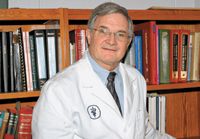An Interview with... Dr. Steven F. Swaim
Find ways to stay passionate about your career, says this professor, author, and researcher. "The enthusiasm veterinary students express when they complete a surgical procedure has helped keep me enthused over the years."
Steven F. Swaim, DVM, MS, is a professor emeritus at the Department of Clinical Sciences and the Scott-Ritchey Research Center at Auburn University's College of Veterinary Medicine. He has received numerous professional, teaching, and research awards including the 1999 AAHA Veterinarian of the Year Award. Dr. Swaim is the coauthor of Small Animal Wound Management.
What is the most exciting change you've seen in veterinary medicine?
The development of specialties within all areas of the profession bodes well for animal health and welfare. Veterinary students can learn the latest information from specialists even though they may be going into general practice. Specialization also has a positive impact on the medical profession in general—comparative medicine within specialties advances both the veterinary and human medical fields. For example, in my area of interest, developments in wound management in both people and animals have been exciting. One such development is the wound healing stimulants that advance the healing process.

Dr. Steven F. Swaim
Who was your most memorable patient?
Three dogs stand out:
- Snoopy, a badly burned coonhound that needed reconstructive surgery. He was an accomplished sire that proved a challenge to bandage in the caudal abdominal area.
- Buddy, a mixed-breed dog that was run over by a train. His case was the first clinical application of a paw reconstruction technique (pad grafts) developed at the College of Veterinary Medicine at Auburn University.
- Robo, a Labrador retriever that stuck its nose in the rotating tail rotor of a helicopter. He was a reconstructive challenge.
Who inspired you most in your career?
My parents were both teachers, and my dad was also a coach and a farmer. I thank them for laying down my spiritual and academic foundation and for helping me develop my work ethic.
Dr. B.F. Hoerlein was my mentor and a second father figure. His support, guidance, and help with my veterinary career are greatly appreciated.
And words cannot express my appreciation for my wife for her support and love. In addition to typing and helping me proofread almost everything I have written over the years, Marj has picked up the slack many times and made it possible for me to proceed in the profession.
What would you advise a new graduate?
After receiving your veterinary medical degree, explore the profession and find your area of primary interest, then figure out how to progress within that field. Finally, proceed with enthusiasm.
My parents gave me a plaque with this quote attributed to Charles M. Schwab: "A man will succeed at anything about which he is really enthusiastic."
What book would you recommend?
The Bible. It has been the operator's manual for my life.
What book are you reading now?
Wakan Man by Fredrick W. Boling. It's about two Scottish immigrants, twin brothers, in the Wyoming Territory in 1866. One brother is a missionary, and the other is a surgeon in the U.S. Army. Studying the Old West, especially Native Americans of the Old West, has been a hobby of mine since I was 11.
What music would you include in your personal jukebox?
I like easy-listening or instrumental music (my sons call it elevator music) playing as I work. A student once asked me during surgery if it was true that your music preferences change as you get older. I told him that they often do. I don't know if he was disappointed or not.
What part of your work do you enjoy most?
First, I enjoy teaching veterinary students, technicians, and veterinarians. The enthusiasm veterinary students express when they complete a surgical procedure has helped keep me enthused over the years.
Second, observing the successful clinical application of a surgical technique that I helped develop is incredibly satisfying. For example, from my days in neurosurgery, my first clinical research project in which the results were applied to clinical cases involved vertebral plating for spinal fractures and luxations. And in the realm of wound management, helping develop the fusion podoplasty technique was memorable because I saw dogs that had chronic fibrosing interdigital pyoderma regain the ability to comfortably walk again.
What do you consider the greatest threat to the profession?
As mentioned earlier, I see the development of specialties as advantageous for the profession. However, I also see the downside for veterinary clinical teaching. As specialties and specialty practices develop, can colleges attract specialists as clinical faculty members? And can colleges attract sufficient clinical cases for teaching?
What makes a good veterinarian?
Good veterinarians are dedicated to and enthusiastic about the field they are in. And good veterinarians are ethical and present a professional appearance to the community. This includes involvement in activities other than veterinary medicine, such as work in civic or church organizations, and, when family is present, dedication to its members.